This is a Nikon EM 35mm SLR camera, which is the Rodney Dangerfield of Nikon SLRs. It came out at a time when the amateur market was exploding and various companies were designing cameras catering to them. Nikon was known for high end pro-level cameras, and when this EM model was released as an entry-level camera, people didn’t know what to think, yet in typical Nikon fashion, it was well built with a couple of features unique to it’s price range.
Film Type: 135 (35mm)
Lens Mount: Nikon F-Mount Bayonet Mount
Lenses: 50mm f/1.8 Series E + many others
Focus: Fixed SLR Prism
Shutter: Focal Plane Vertical Metal Blade
Speeds: B, 1 – 1/1000 seconds
Exposure Meter: TTL Center Weighted CdS meter with Analog Needle Viewfinder Readout
Battery: 2 x S76 Silver-Oxide or Alkaline Battery
Flash Mount: Hotshoe
Manual: http://www.cameramanuals.org/nikon_pdf/nikon_em.pdf
History
I’ve written over a dozen camera reviews on my site, and I haven’t yet written a Nikon review despite having at least 6 in my collection (both digital and film). I feel like Nikon is so well known, there isn’t much I could really contribute to the world that isn’t already so well documented. So I guess it’s fitting that my first review is for the lowly Nikon EM, the most basic, entry level SLR Nikon has ever made.
If you were to ask old school film photographers, they’ll tell you that the EM was not a popular model and that no one took it seriously when it came out. They’ll tell you about how it’s made out of cheap plastic, it doesn’t have features like mirror lock-up, depth of field preview button, no manual modes, no real EV compensation, and a bevy of other complaints.
Throughout the 60s and 70s, SLRs were getting smaller and lighter. Pentax started it off in the early 60s with their smaller than usual S-series SLRs, and by the early 70s, Olympus had released the OM-1 which was the first fully featured compact SLR that took weight and size into consideration. As the 1970s progressed, Canon, Minolta, Konica, and pretty much every other camera manufacturer released their own line of light weight, compact, and inexpensive SLRs. Nikon even released the FM and FE in 1977 which were well-featured midrange compact SLRs, but they weren’t quite entry level. Most people at the time held the FE and FM to a little higher regard than the economy models that other companies were offering.
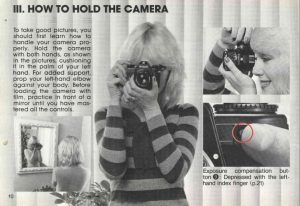
That all changed in 1979 when Nikon released both the EM, and a new line of economy lenses called Series E lenses. Perhaps it was Nikon’s reputation for such high quality that caused concern for so many photographers. They weren’t used to hearing the words “economy”, “light weight”, and “plastic” in the same sentence as “Nikon”. Nikon’s marketing at the time was gearing this camera towards women, but female photographers rejected the idea of a diminutive camera made of plastic just for them. Nikon’s 2015 website amazingly still says this camera is “for Women”.
The Nikon EM and Series E lenses didn’t sell well, but I would hesitate to call them complete failures. I think the biggest problem was that professional and mid-level photographers already had Nikons that catered to their needs, and casual photographers were becoming increasingly interested in simple point-and-shoot models. Within a year or two after the EM was released, the market for an easy to use and light weight SLR for amateurs was already drying up. According to Wikipedia, this camera was made until 1982 and new stock was sold until 1984. It was replaced by the similar Nikon FG which added full program Auto Exposure mode, TTL flash metering, and a +/- exposure compensation dial. Nikon would discontinue the entire Series E line by the end of 1985.
I was not able to find any info about production or sales numbers, but as of this writing, there are currently 246 Nikon EMs for sale on eBay compared to 174 of the supposedly more popular Nikon FE which would indicate that for there to be that many still for sale 36 years after it’s debut, more than a few had to have been sold.


In hindsight, the first ever “plastic” Nikon turned out to be a pretty solid and reliable camera. The fact that many of these cameras are still in good working condition, dispels one of the primary concerns that this camera was cheaply made. The Series E lenses that accompanied it also turned out to have almost as good of optics as non Series-E lenses. The images to the left and right were done using 3 different Nikon lenses from 3 different time periods and I couldn’t see any differences between the three. I only show you the Series E shots here since showing the others would be like looking at the same image 3 times.
Upon browsing through the 246 EMs on eBay, most of them seem to be in decent shape. I picked up my example for $8 and it works fine. I wonder what people would have thought if someone from the future could go back in time to 1979 and tell people that many of these cameras would still be in good working order well over a third of a century later.
People’s memory of this model seems to be colored by the belief that this was an inferior camera, when in reality, it was a well built Nikon that had features that many “economy” models lacked such as metal shutter curtains (as opposed to cloth ones), and the ability to at least partially work with a dead battery. The Nikon EM could still fire it’s shutter in Bulb and 1/90 second modes, and an undocumented feature is that if the camera is set to AUTO, the shutter will fire at approximately 1/1000 sec with a dead battery, meaning a photographer was not completely helpless with a dead battery. Most economy models like the Canon AV1, Minolta XG1, and Olympus OM10 were completely useless without a good battery. Nikon even sold an accessory flash and motor winder that allowed the camera to shoot at 2 frames per second.
In addition to these features, the polycarbonate panels covered an aluminum body which was solidly built. There are no fitment issues anywhere on the body and the camera does not creak in your hand like a low end plastic camera might. The EM was only available in black, which often was the color of professional level cameras, and unlike other black metal cameras, the EM would never show any signs of brassing near the strap lugs as it aged.
Sure, the EM lacked features like mirror lockup, a depth of field preview, and it had lightweight polycarbonate (fancy for plastic) top and bottom panels, but so did the models that directly competed with it. Maybe the small and lightweight body turned people off. Without a lens mounted, the EM comes in at 460 grams, but that is exactly the same weight as the Pentax ME, and 30 grams heavier than the lightweight champ, the Olympus OM10.
Perhaps the best feature of the EM was that it wasn’t just limited to the Series E lenses. It was fully compatible with all Nikon Ai and Ai-S F-mount lenses designed for other Nikon SLRs (It was however, not compatible with Non-Ai lenses). This means that customers could get started with an EM body and buy optically superior f/1.4 primes, wide angle, and telephoto lenses, and then upgrade to a different Nikon body and keep using the same lenses.
I made the following chart comparing the features of the EM to that of similar cameras of the era. I included both the Canon AE-1 and AV-1 even though the AV-1 would have been more of a direct competitor to show how the EM holds up to the AE-1 which was one of the most popular SLRs of all time.
Year Released |
Price (Body Only) * |
Weight |
Exposure Mode |
Shutter Speeds |
Manual Speeds |
Mechanical Speeds |
Shutter Curtains |
Metal Body |
Hotshoe |
Mirror Lockup |
DOF Preview |
|
Nikon EM |
1979 |
$144.95 |
460g |
Av |
B, 1 – 1/1000 |
B, 1/90 |
B, 1/90, 1/1000 |
Metal |
No |
Yes |
No |
No |
Canon AE1 |
1976 |
$189.00 |
590g |
Sv |
B, 2 – 1/1000 |
B, 2 – 1/1000 |
None |
Cloth |
No |
Yes |
No |
Yes |
Canon AV1 |
1979 |
$119.95 |
512g |
Av |
B, 2 – 1/1000 |
B, 1/60 |
None |
Cloth |
No |
Yes |
No |
No |
Minolta XG1 |
1978 |
$149.95 |
??? ** |
Av |
B, 1 – 1/1000 |
B, 1 – 1/1000 |
None |
Cloth |
No |
Yes |
No |
No |
Pentax ME |
1976 |
$164.95 |
460g |
Av |
B, 8 – 1/1000 |
B, 1/100 |
B, 1/100 |
Metal |
Yes |
Yes |
No |
No |
Olympus OM10 |
1979 |
$164.95 |
430g |
Av |
B, 1 – 1/1000 |
Adapter Req’d |
None |
Cloth |
No |
Yes |
No |
No |
* The prices in the above chart are from an advertisement from Ritz Camera on page 183 of the July 1981 issue of Popular Photography.
** I could not find any info about how much the XG1 weighs, but I have an XG7 which is a very similar camera, and I can tell you it is noticeably heavier than the EM. I would guesstimate it is closer to the AV-1 which is 512g, but I do not have a scale to actually measure it myself.
As you can see, the Nikon EM is comparable in many ways to its competition, but maintains compatibility with a huge selection of Nikkor lenses, has an all metal shutter, and features mechanical modes that several of its competitors lacked all for a price that was second cheapest only to the Canon AV-1.
Today, opinions are still mixed on the EM. There are those who still have it in their heads that this was an inferior camera that was made cheaply and not worth a serious photographer’s time. On the other hand, if you search for recent reviews on the Internet of this camera, there are several who give it high praise as an easy to carry and capable camera that has stood the test of time, and when paired with one of many excellent Nikon lenses, it is capable of great shots.
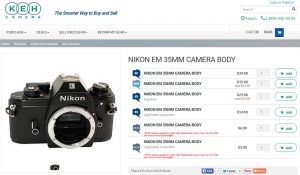
You can easily find EMs for sale on eBay for under $20 in working condition. KEH regularly has EM bodies in As-Is condition for $7. Of course, there’s no guarantee these cameras would work, but you could buy 4 of them with the hope that at least one works for less than you could most other cameras in the chart above.
My Thoughts
I started off this review saying that I am kind of a “Nikon guy”. Prior to my re-infatuation with film, I had been shooting Nikon DSLRs for about a decade. I bought my first Nikon, a D60 in 2006 when I worked part time at Best Buy. Since then, I’ve upgraded a couple of times to my current D7000. I have a couple of lenses, and when I sought out my very first film SLR, I went with a Nikon EL2 because I knew the lenses for that camera would work on my D7000.
Since then, I have accumulated a variety of Nikon SLRs, the most recent being this EM. Going solely off the reputation of this camera, I was curious about how bad it could really be. After all, film photography is more about the quality of the lens and the actual film itself, rather than the body of the camera. A lightweight and compact Nikon that takes all of the other lenses in my collection seemed rather appealing. Then one day while browsing eBay, I saw this camera (body only) for a couple of bucks. For the heck of it, I set a max bid of $10 and got it for $8. When it arrived, I noticed it was already in pretty good condition. All it needed was a gentle wipe down and it was ready to go. I put in a battery and tested everything and all seemed to be in good working order. It would take me several months to get around to shooting with it, but when I did, I paired it with the 50mm f/1.8 Series E lens that I already had and went out shooting.
If its not already very obvious, this is a small camera. It is the smallest and lightest SLR I own, even smaller and lighter than a Nikon D3000. Its smaller than many of my rangefinders like the Yashica Electro and Konica Auto S2. The Series E lens is very shallow, almost “pancake lens” size. You could very easily fit the entire camera and lens into a jacket pocket without any issues.
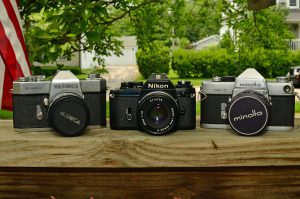
I get why Nikon wanted this camera to appeal to women, especially considering many SLRs of the 70s were still of the older 60s design that were huge. Put this thing next to a 60s Minolta SR-7 or a Yashica TL-Super, and its astonishingly small. Yet, even though I am a guy with what I would consider to have average sized hands, I don’t find the camera uncomfortable to hold.
The camera is aperture priority only with only 2 manually selectable speeds, M90 (which is 1/90th of a second) and Bulb mode. The automatic modes are step less from 1 second to 1/1000 second. If you need an exposure time longer than 1 second, you can use Bulb mode. You can see which shutter speed the camera is going to select by looking at an analog scale inside of the viewfinder. A needle will point to the selected speed when you half press the shutter button. Once the meter is activated, it will stay on for about 20 seconds after you touched the button last, at which time, the camera will automatically power down.
The EM has a distinct feature wherein the camera will make an audible beep if the selected shutter speed is below 1/30 second, or if 1/1000 would overexpose the image. This beeping is only a warning, and will not prevent you from continuing to fire the shutter. If you hear this sound, you either need to change the aperture so that the image wont be overexposed, or in the case of a slow shutter speed, make sure the camera is stable enough so as not to blur the picture. The shutter release is threaded for a shutter release cable if you wish, but this being targeted at novice photographers, I doubt this was used by many people.
The camera does not have a proper + / – exposure compensation feature like many cameras of the era did, but it does have a button on the front of the camera for back-lit scenes where upon pressing the button before firing the shutter, the camera will overexpose by 2 stops. This is useful for when you are shooting a subject in front of a bright background like an exterior window, the sky, or any other light source. In some ways, this feature is actually more useful than a + / – exposure dial because the + 2 overexposure is only in effect while the button is pressed. Once you release the button, the camera immediately returns to normal functionality. On other cameras with a + / – dial, you have to remember to turn the dial back to zero, otherwise the camera will continue to over or underexpose subsequent shots. If you need any more control of exposure, you can always trick the camera by changing the film speed dial to something else to achieve a + or – exposure.
Everything else about the EM is pretty typical of a manual focus SLR. The ergonomics on this camera are great, loading film is easy, and as I’ve said many, many times, the camera is light weight and fits very well in your hand. Its neither too big to handle for people with small hands, but it’s also not so small for people with large hands. It’s like the ‘mama bear’ of cameras!
My Results
Unlike other vintage camera reviews where I comment on what it was like to shoot with the camera and then show you some samples of what I got out of it, this time I’ll just say that yes, the Nikon EM is a Nikon. If you have good lenses for other Nikon bodies, you can use them here (except Non-Ai lenses) and get nearly identical shots. Looking at the 4 shots below, any of these could have been taken on a Nikon F, FTn, FM, EM, or any other Nikon body made in the past 50 years.
I have to admit though, that after reviewing my first test roll, I noticed that some images had light leaks on the left side of the film. Its most visible in the shot of the green pepper below. As it turns out, my EM needed new light seals and I neglected to replace them in my excitement of shooting with this camera. Since getting these pictures back from the lab, I have replaced all of the light seals on my EM, but I have yet to shoot another roll in it.
So, there you have it. Should the Nikon EM be the first Nikon you recommend to someone? It might be! It just depends on what they want. As much as we often gravitate to the “biggest and baddest”, sometimes less is more. There is an appeal to having a light weight and compact, yet very capable SLR. In terms of size, my Nikon D7000 DSLR makes the EM look minuscule. It’s actually funny how large and heavy modern digital cameras are compared to older film cameras. In many consumer electronics, as things get more advanced, they also get smaller and lighter. That’s definitely not the case here.
| My Final Word | It should be pretty clear that the EM is a fine camera. If anyone tells you otherwise, they’re probably pretty closed minded. I wholeheartedly recommend this camera as a backup or second Nikon to pair with your existing lenses because of its small size, but even if it’s your first Nikon, it’s a great introduction to the brand. | ||||||
| Images | Handling | Features | Viewfinder | Feel & Beauty | History | Age | |
| 2 | 2 | 1 | 2 | 1 | 0 | 0% | |
| Bonus | none | ||||||
| Final Score | 8.0 | ||||||
Additional Resources
Its worth commenting that all of these reviews of the EM were written within the past 15 years and all say much of the same things I am saying, that the EM is not deserving of it’s reputation.
http://camera-wiki.org/wiki/Nikon_EM
https://en.wikipedia.org/wiki/Nikon_EM
http://mir.com.my/rb/photography/hardwares/classics/emfgfg20/em/
http://imaging.nikon.com/history/chronicle/cousins11-e/
http://www.sheldonbrown.com/org/cameras/nikon-em.html
http://www.nikonians.org/reviews/the-nikon-em
http://www.lomography.com/magazine/174181-nikon-em-pro-on-the-outside-carefree-on-the-inside
http://randomphoto.blogspot.com/2013/02/the-little-slr-that-could-nikon-em.html
http://www.amateurnikon.com/2015/02/nikon-em-yes-film-camera-review-in-2015.html
https://www.flickr.com/groups/962702@N20/
http://throughtheeyeofe2.blogspot.com/2013/02/nikon-em-can-you-live-with-this-little.html

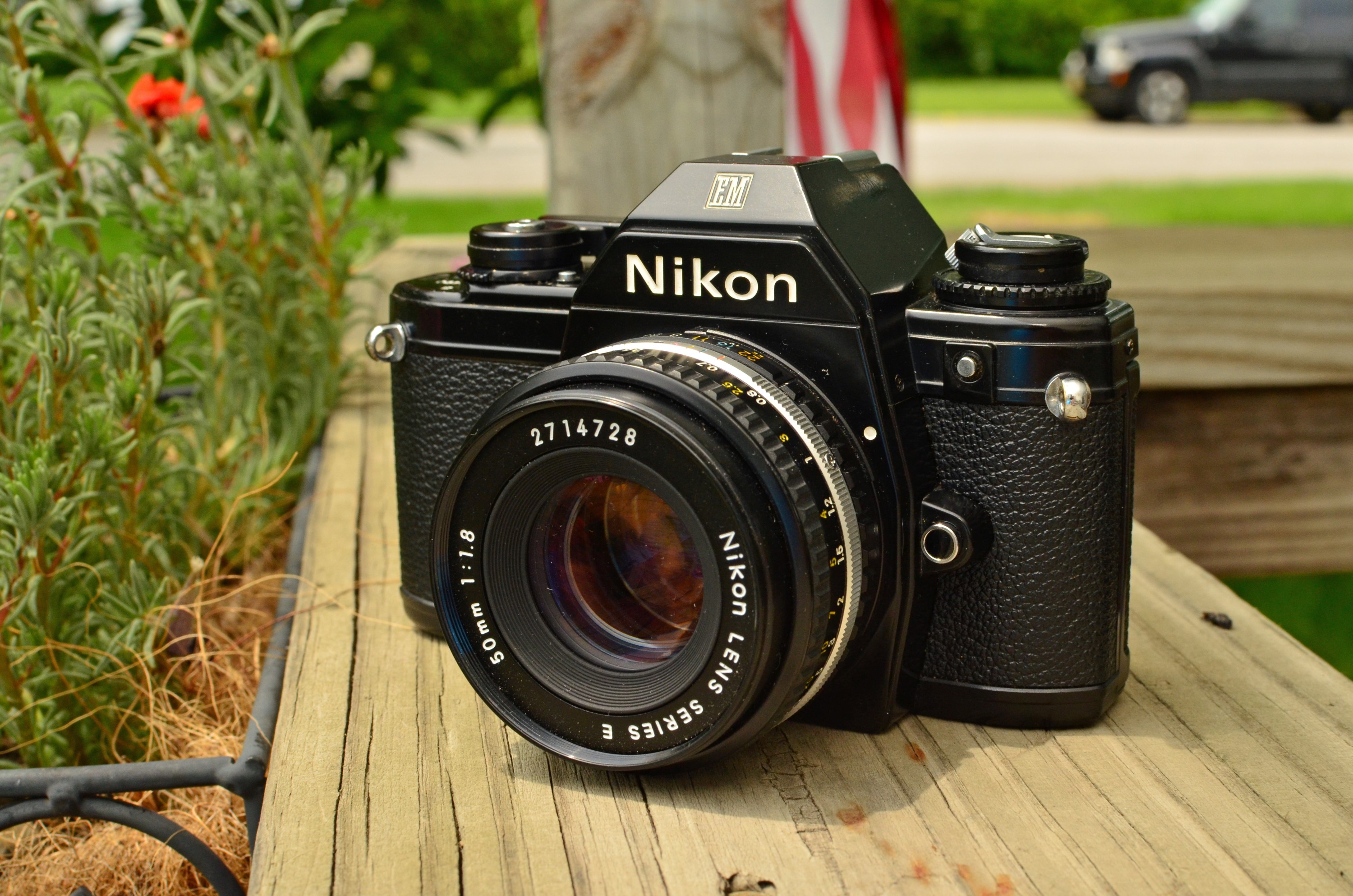
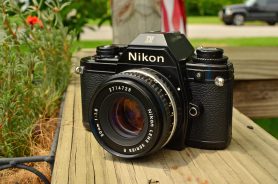
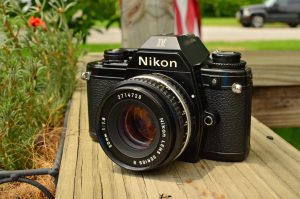




The em can actually time automatic exposure much longer than 1 second.
Try it. I’ve managed up to 2 minutes, with good accuracy.
Hi – I have an EM that doesn’t have a light seal at the door hinge. No evidence it ever had one – it’s spotlessly clean in the back. Family member purchased it brand new. Are these supposed to have a seal at the door hinge?
Perhaps it got missed off the right-hand edge of your chart, but the EM has a mechanical speed of 1/90th, too, if it has no battery, or if the battery’s died.
This was helpful to me. I have one of these cameras that my father gave me. I don’t use it, I don’t even remember how to open it. is it worth keeping for no reason other than it was given to me. I have a variety of lenses for it too. Still don’t know what to do with it but at least I know sort of hwat it does.
My best advice is that this camera will have much more sentimental value as something given to you by your father, than you could ever hope to get by selling it. The Nikon EM is a fantastic and very capable camera that you can still use today and I definitely encourage you to get some film, learn how to use it, and give it a try! Even if you end up never shooting it, it would look nice on a shelf!
Slight correction for your comparison chart regarding the Olympus OM10. It has two speeds available when not set in Auto mode.
The mode selector switch includes a Bulb setting. And setting the mode selector switch to Manual WITHOUT attaching the Manual Adapter sets it to 1/60. (This was how you used electronic flashes other than the companion Olympus T series with this camera.)
Re the Nikon EM, my roommate got one back in 1980 and it was a very capable performer.